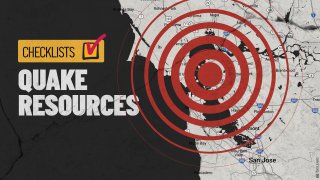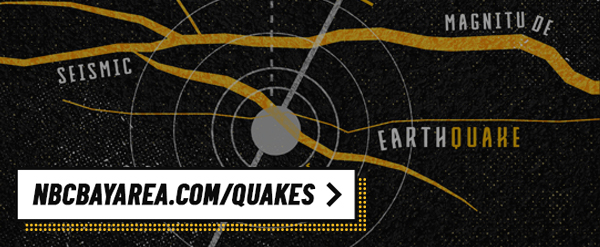
During an earthquake, the goal is to prevent injuries from falling or from objects that might fly towards you. Here's a checklist of quick reminders, built from a wealth of resources and past reports, to help keep you safe in a myriad of scenarios.
QUICK VIEW
- DROP, COVER AND HOLD ON!
- Do not stand in a doorway
- If indoors, stay inside until the shaking stops
- If outside, drop to the ground and safely get into the open
- If in bed at home, cover your head and neck with a pillow, keeping arms as close to your head as possible until the shaking stops
- If in a vehicle, carefully pull over and move your car to the shoulder - then, set the parking break
- If in a wheelchair, make sure to lock your wheels
- If at a BART station, back away from the edge of the trackway
- If in a stadium, do not leave until the shaking is over
- If you are near the shoreline, walk quickly to higher ground - a tsunami may arrive within minutes

DROP, COVER, AND HOLD ON!

- DROP DOWN TO YOUR HANDS AND KNEES
- Wherever you are, drop down onto your hands and knees
- The position protects you from falling and reduces you chances of being hit by flying objects
- Hold on to something sturdy
- COVER YOUR HEAD AND NECK WITH ONE ARM AND HAND
- If a sturdy table or desk is nearby, take shelter underneath if possible
- If no shelter is nearby, crawl next to an interior wall (away from windows)
- Stay on your knees or bent over to protect vital organs
- HOLD ON UNTIL THE SHAKING STOPS
- If you are under a table or desk, hold on with one hand until the shaking stops -- and be ready to move with it if it moves
- If you do not have shelter, hold on to your head and neck with both arms and hands

DURING A QUAKE, DO NOT...
- DO NOT go outside if indoors
- Move as little as possible - most injuries occur because of people moving around, falling and suffering sprains, fractures or head injuries
- DO NOT stand in a doorway
- Doorways are no stronger or safer than any other part of the house
- Doorways do not protect you from the most likely source of injury − falling or flying objects
- DO NOT be surprised if sprinkler systems or fire alarms activate
- DO NOT use the elevators
Get a weekly recap of the latest San Francisco Bay Area housing news. Sign up for NBC Bay Area’s Housing Deconstructed newsletter.

IF INSIDE OR INDOORS DURING A QUAKE
- DROP, COVER AND HOLD ON!
- Stay inside until the shaking stops and you're sure it's safe to exit
- Stay away from windows, exterior walls, hanging objects, tall furniture, televisions, cabinets and glass
- You are safest under a table or desk
- If there is no shelter, move against an inside wall
| SCENARIOS | NOTES |
|---|---|
| IN A STORE | • For extra protection, get next to a shopping cart, beneath clothing racks or onto the bottom of a large shelf to provide extra protection from falling objects |
| IN A HIGH RISE BUILDING | • Move away from windows and outside walls • Stay in the building • If you are trapped, stay calm and try to tap hard on metal parts of the structure to get someone's attention |

IF OUTSIDE DURING A QUAKE
- Drop to the ground
- Get into the open - crawl to open space if you can safely do so (stay there until the shaking stops)
- Stay away from building exteriors, power lines, chimneys, streetlights, signs, vehicles, trees and other hazards
- Stay outside
- If you are in a mountainous area, watch out for falling rock, landslides, trees and other debris that could be loosened by quakes

IF AT HOME DURING A QUAKE
| SCENARIOS | NOTES |
|---|---|
| IN THE LIVING ROOM | • DROP, COVER AND HOLD ON! • Be extra careful about being trapped under tall furniture that toppled over or lighting fixtures |
| IN BED | • Stay in bed • Cover your head and neck with a pillow, keeping arms as close to your head as possible until the shaking stops • Lie face down face down to protect vital organs • Have a flashlight near your bed because power may be out |
| IN THE BATHROOM | • Cover your head to protect yourself from any shattered glass from mirrors or light bulbs • Quickly get out of the bathroom and move to a safe place |

IF IN A VEHICLE DURING A QUAKE
- Avoid overpasses
- Carefully pull over and move your car to the shoulder or curb (away from utility poles, overhead wires and overpasses)
- Stop the car and set the parking break
- Stay inside the car until the shaking stops
- Watch out for powerlines or objects that can fall
- Have an emergency kit in your car along with sturdy shoes in the event you may have to walk

IF IN A WHEELCHAIR OR SEATED DURING A QUAKE
- LOCK, COVER AND HOLD ON
- Make sure your wheels are locked
- Remain seated until the shaking stops or carefully get as low as possible
- If you are seated and unable to drop to the floor, bend forward, cover your head with your arms, book or pillow
- Then, hold on until the shaking stops

IF ON BART (OR SUBWAY) DURING A QUAKE
- Sit down if possible or grab a handhold to avoid injury
- Back away from the edge of the trackway (if at the station)
- Emergency response personnel will coordinate evacuation if necessary

IF IN A STADIUM OR THEATER DURING A QUAKE
- Drop to the ground in front of your seat or lean over as much as possible
- Cover your head with your arms as much as possible and hold onto your neck with both hands
- Do not leave until the shaking is over
- Walk out slowly, watching for anything that could fall

IF NEAR THE SHORELINE DURING A QUAKE
- A tsunami may arrive within minutes
- As soon as the shaking reduces enough that you are able to stand, walk quickly to higher ground or inland

BAY AREA QUAKE CENTRAL
You can take steps to plan and prepare for the next big one. Access our Bay Area Quake Tracker, the latest earthquake stories, extensive quake prep checklists, videos and many other disaster preparedness resources all in one place: NBCBAYAREA.COM/QUAKES

